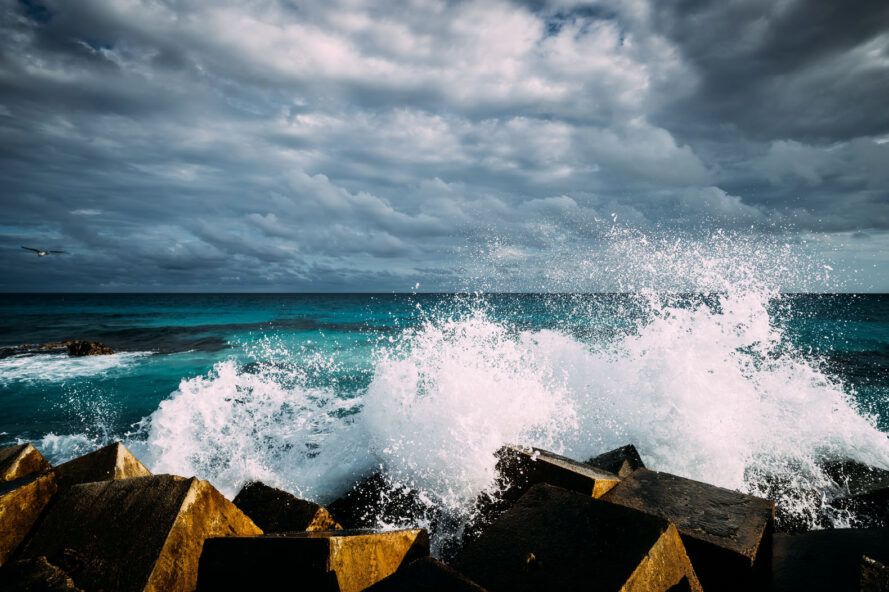
The power and benefits of using tidal energy
Although it’s been debated for decades, the topic of tidal energy has dominated the headlines of late. What is it, what benefits does it offer and what’s the potential for its future use? We’ll tell you.
Continue reading below
Our Featured Videos
What is tidal energy?
Water in motion has the potential to produce power. That’s the essence of tidal energy. There are three primary ways tidal energy is produced. The first is by placing turbines directly into the ocean floor, which is very similar to how wind turbines work on land. The second is in the form of a tidal barrage, which is similar to a dam. A barrage is installed underwater, controlling the collection and release of water. And the third is by creating holding tanks that fill and drain along the coastline, called tidal lagoons. Each system comes with pros and cons, however, they are all being considered in the hunt for reliable, clean energy.
Related: World’s largest tidal turbine receives additional funding

Pros of tidal energy
For starters, tidal energy, also known as wave energy, is endlessly renewable. As long as the ocean ebbs and flows, energy can be sourced. Even better, when the produced energy is used, it doesn’t impact the production of more renewable energy. In other words, production can be unlimited regardless of how much we use.
Tidal energy is also a clean source of energy, meaning not only is it produced naturally without fossil fuels, but when tidal energy is used, it doesn’t release any carbon emissions.
In addition, tides are predictable, which means so is the production of energy. It’s more reliable than solar or wind, both of which can fluctuate significantly.
Another advantage of tidal energy is that it is an efficient means of energy production. Due to the density of water, the process results in much higher production than other forms of renewable energy.
Cons of tidal energy
Along with the advantages of wave energy, come the challenges in its production. One significant challenge is the lack of suitable sites for tidal turbines. The ideal environment has specific requirements, including a wide variation between high and low tides and a geographic location along the coastline. That eliminates a lot of possibilities.
Cost is another factor that limits energy production via tidal power. Since these systems cost significantly more than other options, adoption has been slow.
Also, even though tidal energy is produced and consumed cleanly, there are environmental factors to consider. There are different types of tidal energy systems, but all of them require blocking, trapping and funneling water in its natural habitat. That means creating obstacles for marine wildlife, possibly endangering them through blocked freedom of movement, destroying their habitat and creating changes to their food chain. The environmental impact is unknown since the implementation of the technology is fairly rare. However, with the current administration’s focus on renewable energy options, the United States is beginning to fund this type of research so we can learn what impact tidal turbines have on animals and the overall ecosystem.
Another primary issue with tidal energy is that it may not align with the needs of the community it serves. In real-time, the tides can produce energy predictably. However, those times may not be the same times consumers are running morning coffee makers or watching television in the evening. Like other forms of renewable energy, if it’s not stored, the collected energy goes to waste. Similarly, if the tides aren’t shifting during peak usage, tidal energy won’t provide the needed output.

Existing tidal energy
It’s not new technology. Developed in the 1800s, farmers used to trap water and then release it, allowing the force to turn a water wheel that powered a grain grinder. Today’s tidal energy comes primarily from barrages, some of which collect energy upon release, while two-way tidal power systems generate electricity from both the incoming and outgoing tides.
Around the world, a handful of tidal energy turbines are churning out power. The oldest in operation dates back to 1966 and is located in La Rance, France. It produces around 240 megawatts, which is enough to power around 45,000 homes. In 2011, the Sihwa Lake Tidal Power Station in South Korea became the largest tidal power producer. The Annapolis Royal Generating Station in Canada powers around 4,000 homes. Several similar projects are at various stages of approval and construction, including the massive Swansea Bay Tidal Lagoon in the United Kingdom and the MeyGen Tidal Energy Project in Scotland.
What’s the future of tidal power in the United States?
The question is actually the same around the world. What is the potential for tidal power and will it become a mainstream contributor? The science is exciting. As mentioned, tidal energy is clean and highly reliable. While that’s worth investing in, the cost so far has been prohibitive. On average, the start-up of a tidal energy plant costs up to 12 times that of wind power. Plus, deep research is needed to better understand the impacts on surrounding ecosystems so we don’t make the same environmental mistakes we made with dams.
Reports are pouring out in regard to the potential for the technology, and several sites around the United States have been targeted for further investigation. If progress in other countries is any example, taking steps now could still mean decades before the energy starts flowing. It’s a complicated issue that requires a comprehensive response.
While the future of tidal energy is unclear, it’s fair to assume it will play a part in energy production. Like all forms of renewable energy, it’s the right tactic for the right regions. We use wind power where there’s a lot of wind, solar where the sun beams freely and geothermal where we can tap into it. On coastlines with the right conditions, it can fill a missing void.
Via Pacific Northwest National Laboratory, Solar Review, US Energy Information Administration, National Geographic, MIT Climate
